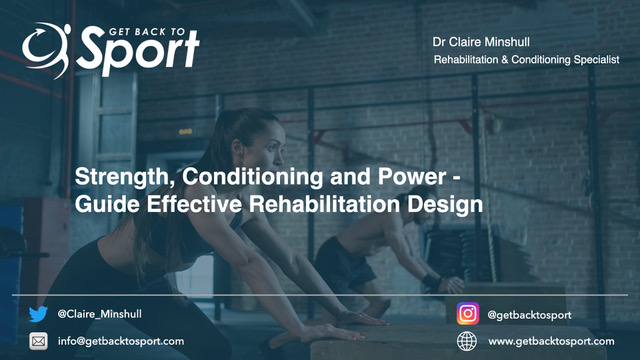This course is not just applicable to therapists who manage athletes. The principles and strategies are very pertinent to older populations and non-athletes alike.
1. Using Strength & Conditioning Principles to Guide Effective Rehabilitation Design
The aim of any rehabilitation programme is to enable the patient to return to function, sports or daily activities, safely, effectively and ideally, as quickly as possible. Often the practitioner must address multiple rehabilitation requirements and restore several indices of function within a time-pressured environment. Managing patients on the fly and generic exercise prescriptions are tempting to get through the workload, but this often results in sub-optimal outcomes and overlooking the basic principles that drive adaptation. In this session we evaluate the core components of exercise prescription: specificity, overload and progression and importantly how to incorporate them into rehabilitation. We also adapt a common technique from sports performance: periodisation, as a simple framework to help you prioritise what paremeters to focus on and when throughout the rehabilitation process.
Specifically:
• Understanding strength & role of neuromuscular performance in dynamic joint stability
• Why you cannot overstate the importance of muscle strength with respect to function, rehabilitation & ageing
• The essential components of rehabilitation design: specificity, overload and progression
• Selecting the appropriate exercise intensity to achieve your outcomes
• What is periodisation & how to apply to rehabilitation
• Managing multiple rehabilitation outcomes, effectively
2. Muscle Power or Muscle Strength? Which Is Most Important In Patient Populations?
Muscle power and muscle strength are different indices of function and they require a different approach to rehabilitation and conditioning. Both parameters are important for performance and mitigating injury across a spectrum of patient profiles, from the the high-functioning athlete to the lower-functioning older-adult. Yet which is most important, when, and in which patients? In this session we explore the relative importance of muscle strength and muscle power in different patient populations and a strategy to help optimise rehabilitation focus.
Specifically:
• Understanding rate of force development (RFD) and muscle switch on times in the context of dynamic joint stability
• How RFD is different to muscle power
• Understand the how muscle power and muscle strength are physiologically different
• A process to follow to determine if strength or power is most important to your patient
• How to design rehabilitation to optimise strength or power development
Upon purchase, access is given for 10 weeks and a certificate of completion is provided to add to your professional portfolio.





